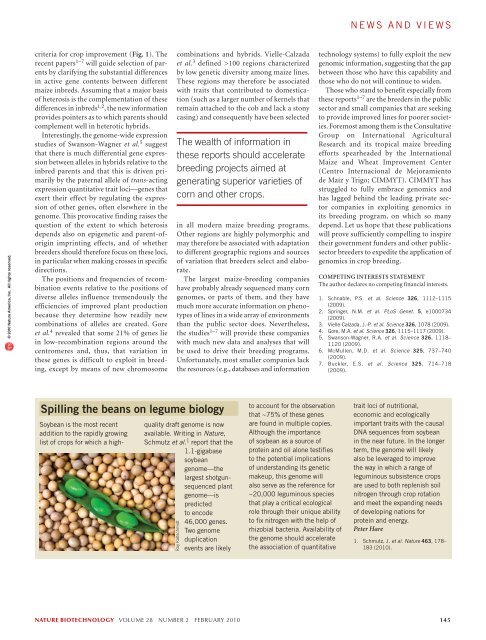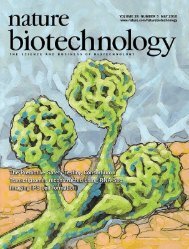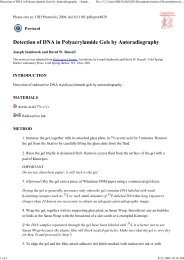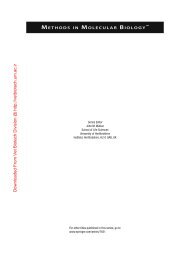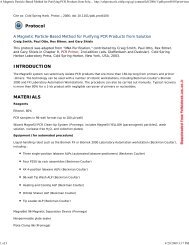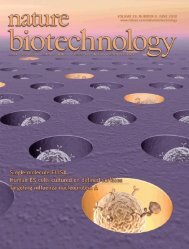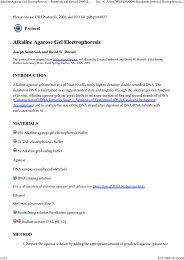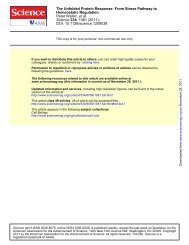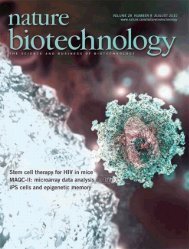news and viewsFrom genomics to crop breedingRichard FlavellNew insights into the maize genome must be incorporated into breeding programs to realize the potential of cropgenomics.© 2010 Nature America, Inc. All rights reserved.A collection of recent papers in Science andPLoS Genetics 1–7 represents a landmark inplant biology and an indispensable resourcefor efforts to improve maize by breeding. Thepapers include the draft genome sequence ofan inbred maize line 1 ; analyses of the chromosomalorganization of genes, microRNAsand transposable elements 1,3 ; comparisonsbetween the genomes of some agriculturallyrelevant inbred lines 4 ; and transcriptionalprofiles of some of the same inbred lines andof hybrids generated from crosses betweenthem 2,5 . The wealth of information in thesereports should accelerate breeding projectsaimed at generating superior varieties ofcorn and other crops.Over 1 billion people eat maize or meatfrom maize-fed livestock. Maize also providesthe raw materials for manufactured productsranging from coatings for paper and cloth tobiodegradable plastics and biofuel. Averagemaize yields over the past 40 years havedoubled in the United States, although notelsewhere. This success was due in part tobreeding of better-performing hybrids, whichare generated by combining the genomes ofinbred plants from different genetic groups.There remains much scope for continuingto improve maize yields by exploiting theyield gain in hybrids relative to their inbredparents, a phenomenon known as heterosis.But to support the world’s growing population,it will be necessary to enhance the rateof increase in the productivity of maize andother crops, especially in inhospitable climates.This challenge will likely be addressedthrough better farming, more reliable seedsupplies and more stable markets, as well asby the application of genomics technologiesto breeding of superior varieties.As most commercially relevant plant phenotypesdepend on the interactions of largenumbers of genes and also on the positionsof genes with respect to one another and tosites of recombination, plant breeding is anactivity that involves whole genomes. Anyplant breeder would like to know, first, howevery chromosomal segment, gene or allele—Richard Flavell is at Ceres, Inc., Thousand Oaks,California, USA.e-mail: rflavell@ceres.netalone and in combination with others—contributesto specific traits, and, second, howto alter the genome to manipulate traits atwill. Historically, these goals remained out ofreach because knowledge of gene–trait associationswas limited by the need to measuretraits in the field and to define their geneticbasis by the inadequate trait mapping proceduresof classical and statistical genetics(right side of Fig. 1). With the advent ofgenomics technologies, breeders can characterizethe allelic content of their particulargermplasm in exquisite detail throughoutthe breeding program and so preserve themost valuable allele combinations (left sideof Fig. 1).Progress in identifying gene–trait associationsfor maize is being achieved by constructingand analyzing “nested associationmapping” lines. In this approach, chromo-Genome-widegenotypingDiverse population ofplants/chromosomesGene-trait associationsSelection of potentialinbred parents of higheryieldinghybridsCrossing of inbredsto make hybridsSelection andevaluation of heterotichybrids for commercesome segments from diverse inbreds arerecombined into sets of inbreds by a verylarge number of recombination events, andthe plants are compared in ways that allowthe roles of individual chromosome segmentsto be inferred 6,7 . The chromosome segmentsare also being defined by their molecularpolymorphisms and by the genes they carry,allowing them to be tracked throughoutthe breeding process. However, a very largenumber of defined polymorphisms will berequired to uniquely mark all alleles. Thishas recently become possible with wholegenomesequencing technologies 1,3 .Integration of the new genomics technologieswith traditional breeding strategies willalso empower breeders in their efforts todesign and select the best combinations ofchromosome segments, genes and allelesavailable in the species to meet commercialTrait analysis infields at multiplelocationsFigure 1 A highly simplified scheme illustrating how genomics can contribute to steps in a maize-hybridbreeding pipeline. Plants selected from parent inbred improvement programs are used in crosses tomake F 1 hybrids that are then evaluated. F 1 hybrids with improved performance are then adopted forcommercialization. Historically, traits could not be managed efficiently as the causal DNA sequencesremained largely unknown and their existence was recognized only through the use of extensive fieldtrials (right side). New genomics technologies to determine complete genomes, DNA polymorphisms,whole genome expression patterns and chromosomal haplotype blocks (reflecting recombinationpatterns) now make it possible to build detailed gene-trait associations and manage such associationsthroughout the breeding program, including the selection of combinations of alleles (left side). Thecombined use of trait assessments in the field and genomics technologies increases the efficiency ofcrop breeding.144 volume 28 number 2 february 2010 nature biotechnology
news and views© 2010 Nature America, Inc. All rights reserved.criteria for crop improvement (Fig. 1). Therecent papers 1–7 will guide selection of parentsby clarifying the substantial differencesin active gene contents between differentmaize inbreds. Assuming that a major basisof heterosis is the complementation of thesedifferences in inbreds 1,2 , the new informationprovides pointers as to which parents shouldcomplement well in heterotic hybrids.Interestingly, the genome-wide expressionstudies of Swanson-Wagner et al. 5 suggestthat there is much differential gene expressionbetween alleles in hybrids relative to theinbred parents and that this is driven primarilyby the paternal allele of trans-actingexpression quantitative trait loci—genes thatexert their effect by regulating the expressionof other genes, often elsewhere in thegenome. This provocative finding raises thequestion of the extent to which heterosisdepends also on epigenetic and parent-oforiginimprinting effects, and of whetherbreeders should therefore focus on these loci,in particular when making crosses in specificdirections.The positions and frequencies of recombinationevents relative to the positions ofdiverse alleles influence tremendously theefficiencies of improved plant productionbecause they determine how readily newcombinations of alleles are created. Goreet al. 4 revealed that some 21% of genes liein low-recombination regions around thecentromeres and, thus, that variation inthese genes is difficult to exploit in breeding,except by means of new chromosomecombinations and hybrids. Vielle-Calzadaet al. 3 defined >100 regions characterizedby low genetic diversity among maize lines.These regions may therefore be associatedwith traits that contributed to domestication(such as a larger number of kernels thatremain attached to the cob and lack a stonycasing) and consequently have been selectedThe wealth of information inthese reports should acceleratebreeding projects aimed atgenerating superior varieties ofcorn and other crops.in all modern maize breeding programs.Other regions are highly polymorphic andmay therefore be associated with adaptationto different geographic regions and sourcesof variation that breeders select and elaborate.The largest maize-breeding companieshave probably already sequenced many corngenomes, or parts of them, and they havemuch more accurate information on phenotypesof lines in a wide array of environmentsthan the public sector does. Nevertheless,the studies 1–7 will provide these companieswith much new data and analyses that willbe used to drive their breeding programs.Unfortunately, most smaller companies lackthe resources (e.g., databases and informationtechnology systems) to fully exploit the newgenomic information, suggesting that the gapbetween those who have this capability andthose who do not will continue to widen.Those who stand to benefit especially fromthese reports 1–7 are the breeders in the publicsector and small companies that are seekingto provide improved lines for poorer societies.Foremost among them is the ConsultativeGroup on International AgriculturalResearch and its tropical maize breedingefforts spearheaded by the InternationalMaize and Wheat Improvement Center(Centro Internacional de Mejoramientode Maíz y Trigo; CIMMYT). CIMMYT hasstruggled to fully embrace genomics andhas lagged behind the leading private sectorcompanies in exploiting genomics inits breeding program, on which so manydepend. Let us hope that these publicationswill prove sufficiently compelling to inspiretheir government funders and other publicsectorbreeders to expedite the application ofgenomics in crop breeding.COMPETING INTERESTS STATEMENTThe author declares no competing financial interests.1. Schnable, P.S. et al. Science 326, 1112–1115(2009).2. Springer, N.M. et al. PLoS Genet. 5, e1000734(2009).3. Vielle-Calzada, J.-P. et al. Science 326, 1078 (2009).4. Gore, M.A. et al. Science 326, 1115–1117 (2009).5. Swanson-Wagner, R.A. et al. Science 326, 1118–1120 (2009).6. McMullen, M.D. et al. Science 325, 737–740(2009).7. Buckler, E.S. et al. Science 325, 714–718(2009).Spilling the beans on legume biologySoybean is the most recentaddition to the rapidly growinglist of crops for which a highqualitydraft genome is nowavailable. Writing in Nature,Schmutz et al. 1 report that the1.1-gigabasesoybeangenome—thelargest shotgunsequencedplantgenome—ispredictedto encode46,000 genes.Two genomeduplicationevents are likelyRoy Kaltschmidtto account for the observationthat ~75% of these genesare found in multiple copies.Although the importanceof soybean as a source ofprotein and oil alone testifiesto the potential implicationsof understanding its geneticmakeup, this genome willalso serve as the reference for~20,000 leguminous speciesthat play a critical ecologicalrole through their unique abilityto fix nitrogen with the help ofrhizobial bacteria. Availability ofthe genome should acceleratethe association of quantitativetrait loci of nutritional,economic and ecologicallyimportant traits with the causalDNA sequences from soybeanin the near future. In the longerterm, the genome will likelyalso be leveraged to improvethe way in which a range ofleguminous subsistence cropsare used to both replenish soilnitrogen through crop rotationand meet the expanding needsof developing nations forprotein and energy.Peter Hare1. Schmutz, J. et al. Nature 463, 178–183 (2010).nature biotechnology volume 28 number 2 february 2010 145
- Page 3 and 4: volume 28 number 2 february 2010COM
- Page 5 and 6: in this issue© 2010 Nature America
- Page 7 and 8: © 2010 Nature America, Inc. All ri
- Page 10 and 11: NEWS© 2010 Nature America, Inc. Al
- Page 12 and 13: NEWS© 2010 Nature America, Inc. Al
- Page 14 and 15: NEWS© 2010 Nature America, Inc. Al
- Page 16 and 17: © 2010 Nature America, Inc. All ri
- Page 18 and 19: © 2010 Nature America, Inc. All ri
- Page 20 and 21: © 2010 Nature America, Inc. All ri
- Page 22 and 23: NEWS feature© 2010 Nature America,
- Page 24 and 25: uilding a businessComing to termsDa
- Page 26 and 27: uilding a business© 2010 Nature Am
- Page 28 and 29: correspondence© 2010 Nature Americ
- Page 30 and 31: correspondence© 2010 Nature Americ
- Page 32 and 33: correspondence© 2010 Nature Americ
- Page 34 and 35: correspondence© 2010 Nature Americ
- Page 36 and 37: case studyNever againcommentaryChri
- Page 38 and 39: COMMENTARY© 2010 Nature America, I
- Page 40 and 41: COMMENTARY© 2010 Nature America, I
- Page 42 and 43: patents© 2010 Nature America, Inc.
- Page 44 and 45: patents© 2010 Nature America, Inc.
- Page 46 and 47: news and viewsChIPs and regulatory
- Page 50 and 51: news and views© 2010 Nature Americ
- Page 52 and 53: news and views© 2010 Nature Americ
- Page 54 and 55: e s o u r c eRational association o
- Page 56 and 57: e s o u r c e© 2010 Nature America
- Page 58 and 59: e s o u r c e© 2010 Nature America
- Page 60 and 61: e s o u r c e© 2010 Nature America
- Page 62 and 63: © 2010 Nature America, Inc. All ri
- Page 64 and 65: B r i e f c o m m u n i c at i o n
- Page 66 and 67: i e f c o m m u n i c at i o n sAUT
- Page 68 and 69: lettersa1.5 kb hVPrIntron 112.5 kbA
- Page 70 and 71: letters© 2010 Nature America, Inc.
- Page 72 and 73: letters© 2010 Nature America, Inc.
- Page 74 and 75: l e t t e r sReal-time imaging of h
- Page 76 and 77: l e t t e r sFigure 2 Time-lapse li
- Page 78 and 79: l e t t e r s© 2010 Nature America
- Page 80 and 81: l e t t e r sRational design of cat
- Page 82 and 83: l e t t e r s© 2010 Nature America
- Page 84 and 85: l e t t e r s© 2010 Nature America
- Page 86 and 87: sample fluorescence was measured as
- Page 88 and 89: careers and recruitmentFourth quart


